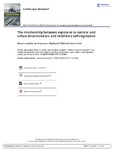The relationship between exposure to natural and urban environments and children’s self-regulation
| dc.contributor.author | Jenkin, R | |
| dc.contributor.author | Frampton, I | |
| dc.contributor.author | White, MP | |
| dc.contributor.author | Pahl, Sabine | |
| dc.date.accessioned | 2018-01-30T14:41:45Z | |
| dc.date.available | 2018-01-30T14:41:45Z | |
| dc.date.issued | 2018-04 | |
| dc.identifier.issn | 0142-6397 | |
| dc.identifier.issn | 1469-9710 | |
| dc.identifier.uri | http://hdl.handle.net/10026.1/10691 | |
| dc.description | peerreview_statement: The publishing and review policy for this title is described in its Aims & Scope. aims_and_scope_url: http://www.tandfonline.com/action/journalInformation?show=aimsScope&journalCode=clar20 | |
| dc.description.abstract |
Research suggests that children living in areas with more greenspace may have better self-regulation, but to date no studies have investigated this capacity immediately following exposure to natural vs. urban environments. To explore this, two studies using between-subjects experimental designs were conducted. Participants, between eight and eleven years old, completed a delay of gratification task (as an indicator of self-regulation) before and after a short (3 min) video of either a natural or built environment or a control display. Potential cognitive and emotional mechanisms underpinning any self-regulation effects were explored using a selective attention task (Stroop test) and by monitoring mood (adapted Cantril’s ladder). Results were mixed. Supporting earlier work, post-test delay of gratification scores were significantly better after exposure to a natural than urban environment, however, compared to controls, it appeared that this effect was due to the depleting effect of the built condition, rather than any restorativeness of the natural condition. Although we also found a marginally significant increase in mood after exposure to the natural environment, this did not mediate the effects of environment on self-regulation. | |
| dc.format.extent | 1-14 | |
| dc.language | en | |
| dc.language.iso | en | |
| dc.publisher | Taylor & Francis (Routledge) | |
| dc.subject | Self-regulation | |
| dc.subject | natural environments | |
| dc.subject | children | |
| dc.subject | greenspace | |
| dc.subject | mood | |
| dc.title | The relationship between exposure to natural and urban environments and children’s self-regulation | |
| dc.type | journal-article | |
| dc.type | Journal Article | |
| plymouth.author-url | https://www.webofscience.com/api/gateway?GWVersion=2&SrcApp=PARTNER_APP&SrcAuth=LinksAMR&KeyUT=WOS:000425782400003&DestLinkType=FullRecord&DestApp=ALL_WOS&UsrCustomerID=11bb513d99f797142bcfeffcc58ea008 | |
| plymouth.issue | 3 | |
| plymouth.volume | 43 | |
| plymouth.publication-status | Published | |
| plymouth.journal | Landscape Research | |
| dc.identifier.doi | 10.1080/01426397.2017.1316365 | |
| plymouth.organisational-group | /Plymouth | |
| plymouth.organisational-group | /Plymouth/Faculty of Health | |
| plymouth.organisational-group | /Plymouth/Faculty of Health/School of Psychology | |
| plymouth.organisational-group | /Plymouth/REF 2021 Researchers by UoA | |
| plymouth.organisational-group | /Plymouth/REF 2021 Researchers by UoA/UoA04 Psychology, Psychiatry and Neuroscience | |
| plymouth.organisational-group | /Plymouth/REF 2021 Researchers by UoA/UoA04 Psychology, Psychiatry and Neuroscience/UoA04 Psychology, Psychiatry and Neuroscience MANUAL | |
| plymouth.organisational-group | /Plymouth/Research Groups | |
| plymouth.organisational-group | /Plymouth/Research Groups/Centre for Brain, Cognition and Behaviour (CBCB) | |
| plymouth.organisational-group | /Plymouth/Research Groups/Centre for Brain, Cognition and Behaviour (CBCB)/Behaviour | |
| plymouth.organisational-group | /Plymouth/Research Groups/Institute of Health and Community | |
| plymouth.organisational-group | /Plymouth/Users by role | |
| dcterms.dateAccepted | 2017-04-04 | |
| dc.rights.embargodate | 2019-1-11 | |
| dc.identifier.eissn | 1469-9710 | |
| dc.rights.embargoperiod | Not known | |
| rioxxterms.versionofrecord | 10.1080/01426397.2017.1316365 | |
| rioxxterms.licenseref.uri | http://www.rioxx.net/licenses/all-rights-reserved | |
| rioxxterms.licenseref.startdate | 2018-04 | |
| rioxxterms.type | Journal Article/Review |


